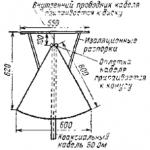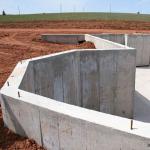At the initial stage of the construction of the entire structure, the foundation is made. The strength and durability of the entire house depends on the quality and correct execution of this structural part of the building. That is why if you make the foundation with your own hands, you should know which design to prefer in this or that case, how to choose the right materials, and also make the foundation of a private house in accordance with all the rules. In our article you will find instructions and video tutorials on building different types of foundations on your own.
General provisions
For the construction of a private house, you can make one of the following types of foundations:
- tape;
- slab;
- pile;
- columnar.
It is difficult to say which of them is the best, since the choice of one or another type of foundation must be made depending on the characteristics of the soil and structural features. The cheapest foundation is not always the best.
When deciding what foundation to make for a private house, you should be guided by general recommendations. It is also necessary to take into account the conditions of construction, namely:
- Before building a house, you need to conduct geological surveys in order to know the type of soil, its composition and characteristics.
- Groundwater depth. These data can also be obtained in the course of hydrogeological studies.
- For the construction of any houses and buildings, you need to know the depth of soil freezing.
- It is also necessary to know the total load from the structure in order to correctly calculate the design of the base and select suitable materials.
- It is important what kind of house you will make, with or without a basement or basement.
- You also need to take into account the materials for the manufacture of the house, as well as the material of the foundation.
- The presence or absence of underground utilities.
If you are making a foundation with your own hands, then you should be aware of common mistakes:
- It is not necessary to lay a shallow foundation for light buildings on heaving soils. In this case, the forces of frost heaving will cause deformation of the structures.
- The foundation must rest on firm ground. It would be a mistake to make the foundation of the house on uncompacted loose soil.
- Do not forget about the lateral pressure of the soil on the walls of the base, as well as the destructive effect of groundwater.
- It is important to use all measures that allow water to be diverted from foundation structures.
Let us consider in more detail the features of the device and the design of each type of foundation, which you can do yourself for a private house.
Tape base

If you decide to make a house with a basement, then the strip foundation is exactly what you need. Such a foundation is used in the construction of houses from heavy wall materials (brick, concrete, reinforced concrete and natural stone) using wooden or reinforced concrete floors. For more information on how to build such a foundation yourself, see the video tutorial offered at the end of the article.
Important: the strip foundation is made under all external walls and load-bearing structures of the building.
This is not the cheapest foundation, but its use is advisable when building a basement, garage, basement or cellar under the house. The weight of the structure is transferred to the foundation tapes. A concrete distribution pad is usually made under the tape. Its width is slightly larger than that of the tape itself. Thanks to this design, the load from the structure is evenly distributed to the ground.
According to the manufacturing method, tape bases are of two types:
- prefabricated structures are assembled from prefabricated blocks installed in trenches or a pit with a crane;
- reinforced concrete monolithic structures are made at the construction site. This option can be done without the use of construction equipment.
For a residential building, you can lay a strip foundation from the following materials:
- reinforced concrete tapes are made of concrete of a class not lower than B 15 - B 30, as well as from reinforcement with a diameter of 10-12 mm;
- rubble concrete structures should be made of concrete and coarse-grained filler (small boulders and coarse gravel);
- brick strip bases can be built from solid clay bricks.
Pile foundations
This foundation is best done if the construction will be carried out on soils with a weak bearing capacity. We can say that this is a fairly cheap foundation, because the cost of materials and the cost of earthworks are minimal. That is why it is very popular.
The entire structure is made in the form of a strip of piles, separate elements or entire pile bushes, united by a grillage or a monolithic slab. As a rule, reinforced concrete or concrete is used to make a slab or beam.
Tip: such a foundation design should be laid if there is weakened soil (loose sandy or subsidence) under the house at a great depth.
According to the type of installation, all pile foundations can be divided into the following types:
- driven (installation is carried out using special equipment);
- screw (such a foundation can be made without the use of construction equipment);
- stuffed (in this case, pipes are installed in the drilled well, into which concrete is poured).
For private houses, pile foundations can be made from the following materials:
- metal, asbestos or plastic pipes (in this case, they act as a fixed formwork, and the reinforcing cage inside the pipe, filled with concrete, serves as the supporting base);
- processed softwood logs (such designs are suitable for light small wooden houses);
- reinforced concrete piles.
Monolithic slab foundation
This is a shallow base, which is made in the form of a monolithic reinforced concrete slab. The height of the structure can be in the range of 0.3-0.8 m. For reinforcement, a rod with a diameter of 12-20 mm is used. Concrete is poured over a sand cushion, which is carried out on a compacted and leveled base of the pit.
Since the load on the foundation in this case is distributed most evenly, this type of foundation can be used:
- on soils with reduced bearing capacity;
- on soils that are subject to the forces of frost heaving;
- for houses with a height of more than two floors and buildings with a complex design.
Column bases
This version of the base can rightfully be called the most economical. It is quite easy to do it yourself. In fact, the design of the foundation is the pillars buried to a certain depth in the ground. From above, all elements are combined into one structure by means of stacked beams.
Important: columnar foundations are suitable for light houses made of timber, logs or aerated concrete blocks with a height of no more than 1-2 floors. Frame and frame-panel houses on a columnar foundation can only be built on soil that is not subject to the forces of frost heaving.
Column bases can be prefabricated and monolithic. As a material can be used:
- stone;
- clay brick;
- logs;
- concrete and reinforced concrete;
- steel pipes.
Strip foundation installation technology

For many private developers, the correct foundation is associated with a strip base, since it is this that is often used in individual construction. Therefore, we will consider the manufacturing technology of a monolithic strip foundation in more detail (it is also shown in our video tutorial at the end of the article).
For work you will need:
- gravel and sand;
- cement not lower than M 200;
- reinforcement with a diameter of 10-12 mm;
- level, plumb;
- rope, pegs;
- formwork boards;
- ruberoid;
- nails, hammer and screws;
- shovel;
- concrete mixer, trough or bucket.
We carry out work on the installation of a strip base in the following sequence:
- We prepare the construction site: remove debris, cut off unnecessary green spaces, level the site. A fertile layer of earth 20 cm thick must be carefully removed.
- We make a breakdown of the future structure on the ground. To do this, use a rope, pegs and a level. The markup sequence is as follows:
- first we find the axes of the future structure, measuring them from the edges of the site or neighboring buildings;
- the distance to the outer face is plotted from the axes (this is how we find the first corner and hammer a peg there);
- then we pull a rope or fishing line from the peg and find the remaining corners of the structure, drive in the pegs;
- then, a distance equal to the width of the foundation tape recedes from the marking along the outer edge of the foundation, the pegs are clogged again, and the cord is pulled.

You can find information on how to properly make a strip foundation in the proposed video tutorial:
How to make the foundation correctly - many are interested in this issue, but not everyone attaches great importance.
If there are loose soils at the base of the foundation, they should be removed, and a sand cushion 15-20 cm thick should be tamped in their place.
This stage of work is extremely important, since the well-being of the future building depends on it.
It is not for nothing that the foundation is considered the basis, therefore, the future fate of the house depends on what this foundation will be and how to do it.
For the construction of the foundation, the following tools and materials are required:
- Shovel and bayonet shovels.
- Water level.
- Wood saw or chainsaw.
- Hacksaw for metal.
- Screwdriver.
- Roulette.
- Nail puller.
- Hammer and sledgehammer.
- Boards or plywood, which are necessary for formwork.
- Line level.
- Metal rods - required for reinforcement.
- Capacity for cement mortar.
- Concrete mix components: cement, gravel, sand and water.
Foundation layout
The markup should be taken with all seriousness, since by value it is the creation of the contour of a future building. Staking out terrain doesn't take long, but that doesn't mean marking out is easy. You should correctly consider the location of future windows, places for the drainage system, the location of the sun and wind.
Marking is done with a hammer, stakes and rope. As stakes, you can take reinforcement rods, the rope should be made of a material that does not shrink or stretch. Good for fishing line.
After that, it is necessary to mark the axis of the building. With the help of a plumb line, the angle of the building is marked, then two perpendiculars to two points are drawn with a stretched cord. This will be the second and third corner. The last corner of the building is determined using a square.
Reinforcement or stakes are driven into the resulting corners. Stakes should be well fixed, not tilted. After that, a fishing line or cord is pulled. The resulting contour should be rectangular, which can be checked with a tape measure and measuring all sides. Opposite sides will be equal to each other. After that, all angles are measured, which should be equal. Then you need to measure the diagonals, and if they are equal, then the building will be really rectangular with right angles.
Mark not only external contours, but also internal ones. This applies to the foundation partitions. Upon completion of the breakdown of the first contour, the second, inner contour is staked out. Axes are marked, in addition, the width of the trench is also indicated and must be equal around the entire perimeter. When using formwork, the width should be calculated with a margin. It is worth paying attention to the fact that the width of the foundation should not be made less than the width of the walls, its minimum width is 40-60 cm.
Back to index
Conducting earthworks
Making a hole under the foundation is not difficult, but there are some tricks here. Earthworks must be done after the marking has been carried out and the demolition has been completed. The cast-off is wooden posts, having a height of about 130 cm. Boards are nailed to it. The height above the ground is 60-80 cm. The boards must be nailed from the outside. The areas of the side nailed boards should be parallel to the contour of the building and located on the same line of the side walls. The top cuts should be located in the same horizontal plane.
In addition, the lowest point must be calculated, which is calculated at one of the outer corners. Depth is calculated from this angle. This is necessary so that the bottom of the foundation is in the same plane, there is no skew of the building.
The cast-off is placed at a distance of 2 m from the building. After that, they go directly to earthworks. Sod is removed from the plot area with a layer of 15-20 cm along with the top layer of soil. On the cleared area, with the help of a cast-off, the location of the pits and is indicated. Further, with the help of a plumb line and a tape measure, their contours are indicated.
Following the outlined contours, they dig a trench. To avoid shedding of the walls of the trench due to their drying, the walls can be strengthened with formwork, how to make it will be discussed later. Starting to dig a trench should be from a hill, where the depth will be maximum. Excessive depth of the trench should be avoided, these places must be covered with sand or gravel, and then compacted well.
Back to index
Sand cushion preparation
A sand cushion is necessary to reduce the load on the lower part of the foundation, which is often necessary during seasonal heaving of the soil. Nevertheless, the sand cushion is designed to save on building materials, to raise the level of the floor above the groundwater level.
It should immediately be said that if there are loose soils at the base of the foundation, then they should be removed, the freed space should be filled with medium-grained sand. The depth of the sand layer should be no more than 20 cm. It is necessary to ensure that the layers of sand are at the same level, there are no slopes or drops. The poured sand must be compacted, pouring water at the same time. Wet sand packs better.
Areas with an elevated groundwater level are a hazard during construction, so it is necessary to equip a sand cushion only after installing an appropriate drainage system. If a sand cushion is flooded with groundwater, then it loses its original meaning.
Back to index
Formwork manufacturing
For the construction of the foundation, formwork is required. This is necessary for a foundation section that rises above ground level. Formwork is installed along the edges of the trench. it is not difficult, the process for its manufacture is a knocking down of a structure made of wooden boards, plywood or twisting metal sheets with screws.
This is followed by the assembly of the frame, which is best done on the ground, which will allow it to be assembled correctly. An edged board will be a good material, its surface is even, therefore the future foundation will also be perfectly even. This will reduce the cost of finishing the foundation and its front side, saving your precious time. In addition, the width of the edged board has one value, this will allow you to monitor the height of the formwork and bring all sides to the same height.
The assembled formwork panels are connected with nails or screws. Please note that the heads of the screws or nails must be on the inside of the formwork, while the nails are bent from the outside. The ends of the shields can be fastened with self-tapping screws, this will reduce the number of gaps and save concrete consumption.
To strengthen the formwork, it is necessary to make or install existing supports and pegs from below and above at a distance of 1.5 meters from each other, securing the outer wall. If it is possible to install more props, then it is necessary to use this, since the load on the formwork increases from the bottom to the top, where the concrete pressure reaches its highest value.
To achieve evenness of the foundation plane, the upper edge of the formwork should be leveled. At the moment, reusable metal formwork is gaining popularity, which allows you to make a foundation that has perfectly even walls.
Back to index
Foundation reinforcement
Reinforcement of the foundation implies the creation of a three-dimensional frame along the entire length of the created trench. The frame is a rectangle connected to each other at the corners of the building. Like any other type of work in construction, reinforcement involves preparation, which must also be done correctly.
The preparatory stage includes fixing the protective material on the inner walls. Parchment is a good protective material. Protection is necessary in order to prevent the boards that make up the formwork from absorbing the moisture present in the concrete. In addition, the protective layer will protect the boards from various kinds of pollution. At the same time, the perfectly smooth surface of the parchment will make it possible to give the same evenness to the outer walls of the foundation.
To create a concrete pour level from above, from the inside of the formwork, an ordinary fishing line is used. With the help of a spirit level, you should align the fishing line in a horizontal plane. As for the reinforcement, it should be with a 12 mm cross section.
The reinforcement is placed inside the concrete foundation at a distance of approximately 5 cm from the edges. For this purpose, you can use a brick that is laid at the bottom of the formwork. It must be positioned so that the grate is entirely inside the concrete mix. The reinforcement is laid on the bottom of the formwork in two rows, the distance between it and the walls of the formwork is 5 cm. The reinforcement must be solid, in other words, it is the skeleton of the building. Then deep and transverse jumpers are attached, forming a lattice of reinforcement.
Welding can be used to secure the reinforcement, but since the surfaces of the foundation can move independently of each other, there is no need for such a hitch. Thus, the coupling of reinforcement is best done with a tie wire.
Back to index
Arrangement of ventilation of the foundation
The element is an important nuance of laying the foundation. To do this, you should take care of creating air ducts - ventilation holes, which are located around the entire perimeter of the foundation. The design of the vents should be carried out before the start of construction, it is necessary to determine the number of holes. Factors such as soil type, depth of laying, average temperature difference, wind direction are taken into account.
The terrain, the location of the house in a lowland or on a hill, also play an important role. For normal ventilation, two ventilation holes from opposite walls of the basement will be sufficient. This condition is suitable for a house located on a hill, but if the building is in a lowland, then the entire perimeter of the foundation should be equipped with air vents.
The presence of normal ventilation is necessary to create sufficient humidity and a normal climate. This will preserve the floors and floor beams on the first floors, preventing the formation of mold. To this end, around the entire perimeter of the building, the ground is covered with sand with a layer of about 15 cm.
To arrange ventilation holes, it is necessary to fix parts of an asbestos-cement pipe with a cross section of 10 cm on the reinforcement beforehand. The pipes must adjoin the formwork. Fasteners are provided with a knitting wire. The internal cavity of the asbestos-cement pipe should be filled with sand to avoid the ingress of concrete mortar into it.
Back to index
Creation of communications
When creating a foundation, you should take into account possible communications such as plumbing, heating, electricity, sewerage. Therefore, even at the stage, it will be correct to allocate space in advance for possible outputs and inputs, holes for pipes and other communications.
To conduct electricity to the house, the foundation must have a communication outlet. The basis for it can be an ordinary metal pipe, with which it will not be difficult to make it. It should be attached to the reinforcement grid, like asbestos-cement, using a knitting wire. But in this case, the length of the pipe is greater than the width of the foundation, and its ends go into the ground.
The depth of laying communications depends on what communication outlets need to be made. In different climatic zones there will be different depths of soil freezing. For temperate latitudes, the depth of soil freezing is 1 m, which is greater than the depth of laying the foundation. The pipe laying depth will be greater, for this reason it makes no sense to make any bends in the foundation for water pipes.
When deciding to build a house, you need to choose a suitable foundation for it. After all, it depends on the foundation how strong the building will be. There are several types of foundation, and you need to choose based on the characteristics of the soil, the weight of the house and your financial capabilities.
Shallow strip foundation
Such a foundation is easy to build and does not require large expenditures. They construct a shallow strip foundation when the weight of the structure is small. It may be a small household. building or one-story house without a basement. The work on the construction of a shallow strip foundation consists of the following items: 
- Site selected and prepared
- Markup in progress
- trenches are digging
- The pillow is poured
- Formwork is being installed
- Fittings are mounted
- Concrete is being poured
Marking is done with ropes. They need to be tied to pegs, marking the places where the foundation will be built.
The depth of a shallow strip foundation is 50 cm for outbuildings and up to 1 meter for a residential building. At the bottom you need to pour crushed stone and sand. First, crushed stone is poured, which must be well compacted. Then you need to compact the sand.
 After that, the formwork is built. If a residential building is being built, then it is better to reinforce the foundation. To do this, a grate is mounted from reinforcement rods with a thickness of 10-12 mm. The distance between the rods is 25-30 cm. They are fastened together with a knitting wire. The grid is placed inside the formwork. The walls of the formwork must be laid with polyethylene or roofing material. If this is not done, then moisture during the solidification of concrete will go into the soil, which will affect the strength of the foundation.
After that, the formwork is built. If a residential building is being built, then it is better to reinforce the foundation. To do this, a grate is mounted from reinforcement rods with a thickness of 10-12 mm. The distance between the rods is 25-30 cm. They are fastened together with a knitting wire. The grid is placed inside the formwork. The walls of the formwork must be laid with polyethylene or roofing material. If this is not done, then moisture during the solidification of concrete will go into the soil, which will affect the strength of the foundation.
For the preparation of concrete, 1 part of cement, 3 parts of sand and 5 parts of crushed stone are taken. For self-preparation of the solution, it is recommended to take cement of grade not lower than M400. The sand used is coarse. It must be washed so that there is no clay.
For mixing, it is best to take a concrete mixer. If there is no concrete mixer, you can make concrete in a large metal container, but so much that the foundation is poured at a time. The foundation cannot be poured in parts, as this will reduce its strength.
 When pouring the concrete mixture, it is recommended to use a vibrator so that the concrete is evenly distributed between the reinforcement bars. If there is no vibrator, you can use a bayonet shovel, repeatedly piercing the solution with it.
When pouring the concrete mixture, it is recommended to use a vibrator so that the concrete is evenly distributed between the reinforcement bars. If there is no vibrator, you can use a bayonet shovel, repeatedly piercing the solution with it.
Now concrete should dry and gain its strength within 4-6 weeks. All this time, the foundation must be looked after. If it rains, it must be covered with polyethylene, and in hot weather, it is necessary to cover the concrete tape with wet rags.
As we wrote above, buildings that are light in weight can be erected on a shallow foundation. For example, or frame garden houses can be built on such a foundation. Read about the construction of frame garden houses in. Such houses can be both for permanent residence and for seasonal.
Buried strip foundation
 A recessed strip foundation is built when they want to make a basement under the house, or if the house is large and above 1 floor. This foundation will cost much more than a shallow strip foundation, so you need to do it only when you really need it.
A recessed strip foundation is built when they want to make a basement under the house, or if the house is large and above 1 floor. This foundation will cost much more than a shallow strip foundation, so you need to do it only when you really need it.
In order to build a recessed strip foundation, perform the following work:
- Choose a site
- Dig a pit
- Install the formwork
- Reinforce
- Pour the solution
 At the selected site, they dig a pit a little more than one and a half meters deep. 1.5 meters is the freezing depth in the central regions of Russia. In the northern regions, you need to dig even deeper.
At the selected site, they dig a pit a little more than one and a half meters deep. 1.5 meters is the freezing depth in the central regions of Russia. In the northern regions, you need to dig even deeper.
After the pit is dug, a pillow of crushed stone and sand is poured onto its bottom. Each layer is well compacted. Then the formwork is built in those places where the walls of the future house will pass. Reinforcement is made inside the formwork, and then concrete is poured.
You can also use ready-made reinforced concrete blocks, but this requires lifting equipment. With blocks, construction goes much faster.
The reinforced concrete tape will serve as the walls of the basement, so waterproofing is performed. To do this, concrete is coated with bitumen or other waterproofing material, for example, liquid rubber. In the place where the basement will be located, the bottom of the pit is concreted. This will be the basement floor. For reinforcement, you can put a grid. After drying, waterproofing is performed.
The described foundations are the most common in low-rise construction, but there are others.
slab foundation
 A slab foundation is a concrete slab on which a house is built. To build such a foundation, you will need to do the following work:
A slab foundation is a concrete slab on which a house is built. To build such a foundation, you will need to do the following work:
- Choose and clear a place for the house
- Dig a small hole in the ground to fit the foundation
- Make a pillow out of gravel and sand
- Lay roofing felt for waterproofing
- Mount power frame
- Install formwork
- pour concrete
A recess in the ground can be 20 centimeters deep. A pillow is poured at the bottom and each layer is compacted. Then you need to make waterproofing. For this, roofing material is usually used, overlapping the sheets. The seams are processed with a blowtorch.
 The roofing material must be positioned in such a way that it bends along the sides of the future concrete slab. After that, it is necessary to connect the power frame from the reinforcement in place of the future foundation. After that, the formwork is installed and the concrete solution is poured. The recommended foundation thickness is 25 cm.
The roofing material must be positioned in such a way that it bends along the sides of the future concrete slab. After that, it is necessary to connect the power frame from the reinforcement in place of the future foundation. After that, the formwork is installed and the concrete solution is poured. The recommended foundation thickness is 25 cm.
After the concrete becomes hard, it is necessary to perform waterproofing at the top of the slab. For this, ruberoid is also used. Then, the top of the foundation is insulated.
The slab foundation allows you to build houses when the ground is heaving.
pile foundation
 Such a foundation is also used in low-rise construction. To make it you need:
Such a foundation is also used in low-rise construction. To make it you need:
- Choose a place for your future home
- Mark it up
- Drill or dig wells
- Lower pipes made of roofing material into them
- pour concrete
- Install the formwork under the grillage
- Pour grillage
If it is possible to use, then there is no need to dig wells. Piles are simply screwed into the ground according to the markup.
When constructing concrete pillars, a pipe made of roofing material is lowered into the well, then a frame made of reinforcement. Then a solution is mixed from 1 part of cement, 3 parts of sand and 5 parts of crushed stone and poured into the well.
After the concrete in each well hardens, they are all connected by jumpers, which are called grillages. To do this, formwork is installed between the piles, reinforcement is performed and concrete is poured.
 In the case of screw piles, the grillage is also made of metal.
In the case of screw piles, the grillage is also made of metal.
The pile foundation is good because it allows you to build houses where the soil does not allow you to make another type of foundation. For example, where the upper part of the soil is loose or saturated with water. Piles transfer the load to the lower, dense layers of soil. On such a foundation, you can build a house even where the soil is rocky, which makes it difficult to dig trenches or a foundation pit.
Judging by , it has an incredibly high construction speed. The erection of walls can be started immediately after the completion of the foundation without any waiting periods. Such a foundation can be built on almost any type of soil.
On a pile-screw foundation, you can build light houses, such as frame or Canadian ones. Read about the construction of a frame house with your own hands in, and about the Canadian technology for building houses -. Canadian houses are gaining more and more popularity in our country, as they perfectly retain heat.
Drainage around the foundation
 The story of foundations would be incomplete without mentioning drainage. With proper construction of the house, drainage is necessary, because it diverts water from the foundation during autumn and spring rains and snowmelt. It is especially needed if the house has a basement.
The story of foundations would be incomplete without mentioning drainage. With proper construction of the house, drainage is necessary, because it diverts water from the foundation during autumn and spring rains and snowmelt. It is especially needed if the house has a basement.
To make drainage, a trench is dug around the foundation, into which a drainage pipe is laid at an angle. You can use a special pipe for drainage, or you can make it yourself. For this, a PVC pipe is taken and small holes are drilled in it.
The pipe is wrapped in a special cloth and covered with gravel and sand. Cloth and powder will not allow the holes to silt, and such drainage lasts a long time. Drainage pipes must be brought to a special well.
Blind area production
 The blind area is a concrete tape that is laid close to the foundation along its entire perimeter. Concrete is poured on a cushion of rubble and sand with a slight slope from the house. The blind area perfectly performs its functions in tandem with the drainage system.
The blind area is a concrete tape that is laid close to the foundation along its entire perimeter. Concrete is poured on a cushion of rubble and sand with a slight slope from the house. The blind area perfectly performs its functions in tandem with the drainage system.
Summary
When choosing a foundation for a house, carefully carefully consider the advantages and disadvantages of each of them.
As already mentioned, there is no need to build an expensive and time-consuming buried foundation for a one-story house without a basement.
A slab foundation will allow you to build a house on heaving soil.
A pile foundation can save even in cases where the top layer of soil, it would seem, is completely unsuitable for construction.
Having built the necessary foundation in accordance with all the rules, you will build a solid and reliable foundation for your future home. And he will stand on it for many years.
Video about building a foundation for a house
Construction of a strip foundation for a house
Formwork and foundation pouring
Reinforcement and formwork of shallow strip foundations
For the construction of low-rise buildings, strip foundations are mainly chosen. Indeed, such a foundation has a simple design. In addition, absolutely anyone can handle the construction of such a structure. Therefore, especially for our readers, the portal will help you learn how to build a foundation for a house with your own hands. Step-by-step instructions and a special video will help us in this work.
Preparatory work
The construction of the foundation cannot be done without a number of preparatory works. The construction site must be cleared first of all of bushes and other debris. It is also necessary to remove all grass that grows on the site. After which, it is recommended to level the construction site. It is recommended to use a grader or bulldozer to level the soil. You can also level the surface yourself. Excess soil is removed from the construction site and low areas are filled with it.
 If the place has already been cleared, then marking work begins. At this stage, an equal line is marked on the surface of the earth along the length of one of the sides of the foundation. At the same time, pegs are hammered along the edges, which can replace pieces of reinforcement. Then the angles are divided into 90 degrees and the length of the transverse sides is measured. Their ends should also be marked with pieces of reinforcement.
If the place has already been cleared, then marking work begins. At this stage, an equal line is marked on the surface of the earth along the length of one of the sides of the foundation. At the same time, pegs are hammered along the edges, which can replace pieces of reinforcement. Then the angles are divided into 90 degrees and the length of the transverse sides is measured. Their ends should also be marked with pieces of reinforcement.
How to check markup location
The markings you made for the foundation must be level. Therefore, after marking, you need to check the evenness of all lines. The evenness of the corner points is checked by measuring the lengths of the diagonals of the resulting rectangle. The diagonals must be even. If differences are observed, the breakdown is rechecked again. If there are no problems with the markings, then a fishing line of good thickness is stretched around the perimeter of the foundation.
The internal perimeter of the structure is fixed on the ground. At the same time, a retreat is made from the previously broken external foundation to the width of the foundation. Pieces of reinforcement or pegs are hammered into all corners and then the fishing line is pulled.
Excavation
In this publication we are talking about how to make a foundation for your home with your own hands. Above we explained for our readers how to make markings for the foundation. If the marking is already ready, then it is necessary to begin excavation work. For a foundation in dense soil, it is necessary to dig trenches, which should be located between the calculated depth and the tensioned line. The last trench should be 20 cm lower than the freezing point of the soil in the construction area. To mark this trench you need to start from the lowest corner on the ground.
 For a finished trench, it is imperative to level the bottom at the same level. For this situation, experts recommend using an engineering or water level. A layer of sand 15 cm thick is poured into one trench with a leveled bottom. For this situation, crushed or river sand is used. The sand layer must be compacted. First, the sand layer is well watered, and then compacted with vibrating rammers. You can also use a special block that has handles for compaction.
For a finished trench, it is imperative to level the bottom at the same level. For this situation, experts recommend using an engineering or water level. A layer of sand 15 cm thick is poured into one trench with a leveled bottom. For this situation, crushed or river sand is used. The sand layer must be compacted. First, the sand layer is well watered, and then compacted with vibrating rammers. You can also use a special block that has handles for compaction.
What to use for sheathing foundation walls
If you don't know how to make an inexpensive foundation for a house, then there is no need to worry. After all, our article will help you learn how to build a reliable and inexpensive foundation for a future building. The walls of the trench must be sheathed. Here, each person can be offered several options to choose from. For example, for this situation it would be suitable:
- ruberoid,
- clay solution,
- cement mortar.
Remember that if you line it at the stages of building a foundation, then in the future it will be possible to prevent water from leaking into the ground from the concrete mixture of the foundation.
 Reinforcement of the foundation must be done at the bottom. In this case, the reinforcement should be 5-7 cm above the bottom of the trench. At this stage, it is recommended to lay three reinforcement bars that are 12 mm thick.
Reinforcement of the foundation must be done at the bottom. In this case, the reinforcement should be 5-7 cm above the bottom of the trench. At this stage, it is recommended to lay three reinforcement bars that are 12 mm thick.
Mounting rods must be placed transversely in increments of 35 cm, which must be fastened to the main reinforcement rods with knitting wire. It is recommended to install such frames in the upper and middle parts of the foundation. Such parts are fixed by tying them to vertically installed reinforcement bars that have a diameter of 8 mm.
How to make a mortar for pouring a foundation
Then they begin pouring the foundation. For this purpose, a concrete composition is used. Anyone can prepare concrete for the foundation with their own hands. To prepare the composition for the foundation, you need to purchase or rent a concrete mixer. For the mixture itself you will need:
- granite crushed stone,
- crushed or river sand,
- water.
Fill the foundation trenches in one go. It is generally not recommended to stretch such work over several days. And to save composition, it is allowed to add to liquid concrete: stones, pieces of concrete and old side stones. Deep vibrators are used to compact the mixture. And if such devices are not available, then compaction can be done on your own. Upon completion of the work, the surface of the foundation is leveled and smoothed with a trowel.
Foundation reinforcement is done completely differently. First of all, the lower frames are laid. Which rest them on bricks. After which the trench is filled to the middle. The surface is leveled and then the middle frames are laid. Then concrete is added again. Then the foundation surface is leveled again and the upper frames are placed. At the final stage, the upper frames are finally filled with concrete.
 After all the work on pouring the foundation has been completed. The structure is left alone for about 7 or 10 days. As soon as this time has passed, they begin to construct the upper part of the foundation, which is called the plinth. To arrange the base, use one of the following materials:
After all the work on pouring the foundation has been completed. The structure is left alone for about 7 or 10 days. As soon as this time has passed, they begin to construct the upper part of the foundation, which is called the plinth. To arrange the base, use one of the following materials:
- brick,
- blocks,
- a natural stone,
- monolithic concrete.
What is formwork made from?
Formwork is created from edged boards. Shields are made from this material. Ordinary plywood is also suitable for constructing formwork. These materials are usually secured along the outer and inner perimeter of the foundation. The materials are also attached to the racks. Which were driven into the ground.
And in order to give rigidity to the structure, you need to use supports from the outside. Before pouring concrete into the structure, you need to cover the inside with polyethylene or roofing felt. The formwork is removed after the concrete has set a little. Now the shields can be disassembled and then stored in a dry place for reuse.
To prevent the foundation of the building from collapsing from melt water and other moisture, it is covered with waterproofing. To do this, use hot construction bitumen and glue layers of roofing material. Subsequently, a blind area is built on the outside of the building, which is 1 m wide.
Any building is based on a solid foundation. The durability of the entire building depends on the correct choice of the type of this structure. How to make a foundation for a house, taking into account all the nuances, so that it lasts for more than a dozen years?
Competent construction work involves the analysis of several factors:
1) type and structure of the soil;
2) selection and correct calculation of the required materials;
3) reliable hydro- and thermal insulation of the finished base.
Properly building a foundation for a house means choosing the right device technology, taking into account all the available conditions and thinking through important details. The process should not be interrupted due to suddenly discovered circumstances or inconsistencies.
Strip base device
The strip foundation is the most common design for central Russia. There are several advantages to this foundation:
- the possibility of building on their own;
- low labor and material costs;
- inside such a foundation, you can equip a basement or underground;
- tapes passing under all load-bearing walls and places of the highest load provide a high level of strength;
- durability of operation.
It is impossible to build a tape-type foundation on heaving soils prone to flooding. You can find out the features of the soil available on the site from specialized organizations conducting geological exploration.
Important: data on the depth of water will be needed not only during the construction of the foundation, but also when planning a water source on the site (well, well or centralized pipeline).
In order to build a solid foundation for a house on ribbons, you will need the following materials:
- sand-cement mixture;
- crushed stone or gravel;
- water in solution;
- unedged boards for the manufacture of formwork;
- wire for knitting a frame;
- reinforcement bars;
- bars for spacers;
- brick;
- waterproofing material;
- nails.
The master will need the following tool: a shovel, a level, a cord, a hammer, a level, a tape measure, a trowel. To prepare a concrete solution, you need a container.
Important: if the tape base must be of decent size, it is more advisable to purchase ready-made concrete with mixers or buy a deep vibrator.
Start of work: site marking and excavation
Any foundation construction begins with the marking of the site. According to the project data, the master must bring the corner and intermediate points of the future foundation to the area. The locations of the points are marked with pegs. The width between two hammered pegs is the width of the foundation strip, which must always be greater than the width of the load-bearing wall. All pegs clogged around the perimeter are connected with a cord or twine.
The accuracy of the markup is necessarily checked by a level, which measures the diagonals of the resulting rectangle. All diagonals of the future base must be equal. If there are arithmetic deviations of even a few mm, marking starts again until an accurate control measurement result is obtained.
After the external markup is done, you can move on to the internal one. The width of the tapes is usually from 30 to 40 cm. Inside the marked perimeter, you need to dig a pit to the depth of the tapes. All walls of the pit must be smooth, without protrusions and depressions.
Important: the depth of excavation for the strip foundation should always exceed the level of groundwater.
Each region of the country has its own value of the freezing point of the soil, the information is graphically depicted on the map.

Usually, a pit is dug to a depth of 1.2 to 1.5 m. This is quite enough for non-rocky and non-flooding soils. Next, you need to form the formwork in the direction of the tapes. For this, an unedged board and pegs are used. Boards are attached to each other with nails.
After the formation of the bottom of the foundation is completed, a pillow of sand and crushed stone (or gravel) is arranged, which is carefully compacted and wetted with water. Experts advise ramming each layer of the cushion separately: first sandy, then gravel. The optimal height of such a puff "pie" is from 15 to 20 cm. The need is due to the function of frost heaving of the soil during the change of seasons. A well-compacted base under the foundation will reliably protect it from the expansion of individual soil layers.
Formation of a reinforced frame and waterproofing of the base
If the master wants to form a support for the house in accordance with all the rules, he must know that the tape structure must have a reinforced frame. The bottom of the pit is lined with bricks, on which reinforcement bars are laid. A mesh should be formed from the reinforcing bars, i.e. they are stacked crosswise. At the joints, the reinforcement is connected with a special wire.
Important: knitting reinforcement requires caution and accuracy from the master, do not overtighten the fasteners.
It is the flexibility required when knitting reinforcement that determines the manual nature of the work. The use of welding will speed up the process, but does not guarantee the strength of the future base.
After tying the reinforcing cage, it is necessary to lay a layer of waterproofing. The most commonly used roofing material, which is durable and affordable price. When laying the roofing material, the sheets are overlapped, and the places of their layering are glued with adhesive tape. This will increase the reliability of the waterproofing and prevent the penetration of groundwater.
Concrete production and foundation pouring
Concrete is made independently or purchased from specialized companies. If the master chooses the first option, it is recommended to purchase only high-quality cement (grades M300, M400). Aggregates should be coarse sand and crushed stone. The ratio table of all components is given in the table.
 Table of the ratio of concrete components when using cement M400
Table of the ratio of concrete components when using cement M400
The better the materials used to prepare the solution, the stronger the finished base will be. An important point is the connection of water with cement, when a certain water-cement ratio (W / C) must be met. This indicator, along with the brand of cement used, is extremely important for the strength characteristics of the base. If concrete is made using gravel, the practical W/C values are shown in the table:
Table 1. W/C values for various grades of cements and concrete mixtures on gravel
| 100 | 150 | 200 | 250 | 300 | 400 | |
| 300 | 0,75 | 0,65 | 0,55 | 0,50 | 0,40 | — |
| 400 | 0,85 | 0,75 | 0,63 | 0,56 | 0,50 | 0,40 |
| 500 | – | 0,85 | 0,71 | 0,64 | 0,60 | 0,46 |
| 600 | – | 0,95 | 0,75 | 0,68 | 0,63 | 0,50 |
Externally, the readiness of concrete can be determined by the tubercle of the mixture at the end of the shovel. If it does not spread and does not drain, then the desired rigidity has been achieved.
Important: the lower the fraction of concrete mortar fillers, the more water will be required.
The ratio of water depending on the fractional size of the plasticizers is shown in table 2.
Table 2. Approximate values of water consumption (in l / m3) in the manufacture of concrete from materials of various fractional structures
| gravel, mm | Crushed stone, mm | ||||||
| 10 | 20 | 40 | 80 | 10 | 20 | 40 | 80 |
| 185 | 170 | 155 | 140 | 200 | 185 | 170 | 155 |
In order for the foundation under a private house to be as strong as possible, it is necessary to prepare concrete with the highest rigidity. The more rigid the solution in its parameters, the more durable the foundation of the house will be.
Concrete is poured into the formwork in layers, each layer is carefully leveled and pierced to get rid of air bubbles. An internal vibrator can be used, but it can damage the reinforcement cage. Baying concrete is an important procedure that increases the strength of the foundation being poured.
The mortar poured into the formwork gains its strength within 4 weeks. During this time, the foundation needs additional protection: if it is sunny and dry, it must be covered with polyethylene and watered regularly. If it is rainy and damp, just cover with a film or geofabric. When the tape base is completely hardened, the formwork is dismantled.
We build a foundation on pillars
Are there any rules for building a columnar foundation? First, you need to know some of the nuances: it is advisable to choose such a base on heaving soil with a deep freezing point. Tapes on moving soil will not withstand constant deformation, and support poles will last for decades to property owners.
For the device of the columnar base, the master will need the following materials:
1) pipes made of metal or asbestos cement;
2) fittings;
3) sand-cement mixture;
During the construction process, you will need a container for preparing the solution, a trowel, a shovel. To mark the area, you will need a level, tape measure, pegs and a building cord.
Implementation of marking and ground operations
The markup sequence is similar to the work on . In the same way, the points of location of pillars-supports are taken out onto the terrain, using the design documentation of the building. The location of the supports: at the corners of the house and in places of the highest load (bearing walls, stairs, transitions, etc.). The optimal distance between the posts is from 1.5 to 2 m.
When the marking is completed, you can come to excavation for the pillars. The diameter of each pit is equal to the cross section of the pipe. The depth should be below the freezing point of the soil. When the pits are ready, a sand cushion 10 to 15 cm high is arranged in them. It is carefully compacted and moistened.
Important: the denser the pillow under the pillars, the stronger the future foundation.
Pillar installation and concrete pouring
After completing the operations on the device of the pillow under the supports of the future base, concrete can be prepared. A solution is prepared in the same proportions as in the case of a strip foundation. The consistency of the finished concrete should resemble thick sour cream.
- an asbestos-cement or metal pipe is installed in the pit;
- a little concrete mortar is poured into the pipe;
- the pipe is raised so that the concrete is distributed over the sand cushion;
- the pipe is leveled with a level in a vertical position.

According to the algorithm described above, all pillars are installed. Next, they are reinforced. 3-5 reinforcement bars are laid inside the pipes so that they go deep into the sand cushion, and the top rises 25-30 cm above the pillars. When all the supports are reinforced, they are poured with concrete. If holes remain around the supports, they are carefully covered with soil and well compacted.
Concrete in pipe supports sets within 1-2 weeks. After this period, you can proceed to the grillage device, which will fill the space between the corner supports and increase the reliability of the foundation being built. Subsequently, load-bearing walls will be placed on the grillage.
Foundation construction on homemade piles
Is there a type of foundation for a house on unstable ground? The way out of the situation is the device of the pile foundation. The main characteristics of this design: durability and high strength, the ability to withstand high loads.
A distinctive feature of the construction is the absence of the tedious stage of excavation and the formation of a foundation pit. Such a base is attached to piles immersed in the soil. The cost of finished piles is not “affordable” for every master, so many people prefer to make these products on their own.
During the construction process, the following materials will be required:
1) fittings;
2) cement with sand;
3) steel wire;
4) roofing material;
The preparation of concrete will require a special container and vibrator. On the ground, the locations of future piles are marked with pegs using a tape measure and a level. For the production of recesses, a hand drill is required.
Well formation
Self-drilling of wells takes place already in the places of the marking placed on the site. The step from one pile to another should not exceed 2.5 meters. The required number of holes is drilled with a hand drill. If water appears in the well during drilling, it must be pumped out with a pump.
Piling and concrete production
After the formation of all the piles, a formwork made of roofing material rolled up into a tube is inserted into them. The diameter of the homemade pipe should be equal to the cross section of the future pile. Soft steel wire fixes the size of the roofing material, after which it is carefully inserted into the well.

In this way, blanks are made for all wells. The purpose of the formwork is to maintain the strength of home-made piles, to prevent the absorption of cement laitance by the soil. In addition, if the mortar is poured directly into the ground, the pile will have an uneven surface. All rough bases are more susceptible to the forces of frost heaving than smooth bases without flaws. A fragile foundation will begin to collapse very quickly, thereby reducing the life of the building.
After immersing the formwork into the wells, it is necessary to make a spatial reinforcing cage. For this, reinforcing bars with a section of 6 mm are used. To form one frame, 3-4 rods are required, fastened every 50 cm to each other. Having installed the structure in the well, it is necessary to see its top above the ground. Protrusion height - from 40 to 60 cm.
Next, you can move on to the production of concrete. The manufacturing technology is described in the section on the strip foundation, repetition is unnecessary. The solution should be fed into the well in batches, filling approximately 0.5 m3 each time.
Important: filling the wells with a solution must be alternated with its bayonet, removing excess air.
Bayonet is performed with a reinforcement bar. To improve the quality of work, you can use a vibration machine, but very carefully so as not to damage the reinforcing content.
Within 2-3 weeks, the concrete will gain strength, after which it will be possible to deal with the grillage. The tops of homemade piles are not cut off, they provide better adhesion of the grillage structure and piles.
Foundation construction on finished piles
What are the main points of building a foundation from ready-made, factory-made piles? The master will need the following set of materials:
- scrap metal;
- 2nd pipe;
- a mixture of sand and cement;
- metal piles;
- ready-made heads;
- anti-corrosion coating;
- water.
Of the tools and equipment, you need to have a shovel, tape measure, level, welding machine and grinder on hand.
Stages of work
Traditionally, construction begins with marking the area. The step between the piles is up to 3 m. Then they start screwing the piles. You can do this manually, involving several assistants, or you can order well drilling from a specialized company. The second option is preferable, but it costs a lot of money.
The depth of the wells should exceed 1.6 m, this prevents them from sticking out during periods of seasonal soil deformation.
Important: if an obstacle is encountered on the way of the pile, you should try to get rid of it and continue working. Only a fully installed pile 100% ensures the strength of the foundation.
The screwed piles are carefully cut to an equal protrusion from the ground, after which the products are concreted. A ready-made solution is poured inside the piles, this prevents corrosion of products in the soil. The final stage is the welding of the heads and the coating of the junction with an anti-corrosion agent.
With this method of construction, there is no need to wait for the final one, it is fashionable to move on to the grillage device and subsequent operations.

























